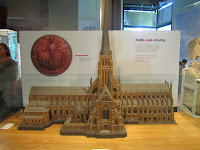 |
| Tower Bridge and the Thames |
A lot of the MA is focused upon cities and London itself so it made sense to visit now. The museum is free to enter and was nicely busy (as in people in all the exhibits but plenty of room to look around) and, the Government would be pleased to know, there were lots of children in there discussing the exhibits with their parents.
Although I could have started in the mid-19th century galleries I did the right thing and began at the beginning. After walking quickly through 'London before London' I did slow down for the Roman galleries. Very enjoyable they were too. On my left is a mock up of a prosperous Roman home. I actually thought that I would be happy to move in. There is also a mock up of a Roman kitchen and various shops and finds. It's very light and the exhibits are well labelled so it's a great area to look around and then there are the exhibits that knock you sideways: the finds from the Temple of Mithras and the real mosaic floor from Milk Street and you have to remember that this place you walk around not really paying attention to has been inhabited and worked in since Roman times! Very exciting!!
 |
| Mosaic from Milk Street |
The Medieval galleries were also extremely interesting. This is a, 100 years old, model of St. Paul's Cathedral. It had the tallest spire in England at that time and was, to my mind, more beautiful than St Paul's looks now with the dome. I suppose it looked like other cathedrals such as Lincoln or Salisbury whilst 'our' St Paul's looks very different to other cathedrals in Britain. What do you think? In addition there were royal items and exhibits of glassware and other household objects - absolutely amazing that these things survive the centuries, especially when they are just household objects and wouldn't have been treated with any care at all.
 |
| The Great Cross in Cheap (now Cheapside, a very busy street in the City) |
I took fewer pictures from now on but the exhibits continued to be extremely good. The (poor) picture on the left is of a model of the Rose Theatre which stood (due to law) just outside the city boundaries and where Shakespeare would have performed with the King's Men. In the Tudor galleries there are interesting and beautiful ecclesiastical pieces, victims of the Reformation and the dissolution of monasteries and churches. Then you go forward to the Civil War (or War of the Three Kingdoms as T tells me it is now referred to) and the Plague/Great Fire of London. You can listen to Samuel Pepys tell you all about it in one gallery and see some evocative and terrifying oil paintings.
Finally, I was in the part of the museum that I had come to see although I must confess that I enjoyed the earlier galleries more. There is a very interesting exhibit about pleasure gardens that I wanted to see because they were still going (for example at Vauxhall) in the period when the MA starts. It's actually a very creative exhibition - lots of dummies wearing the most beautiful clothes in a small room that looks like a very small part of the garden. There was a film to watch but I had a bit of a Doctor Who moment and decided I wouldn't stay in there alone in case the dummies came to life.
The final galleries included the Lord Mayor's Coach which is incredibly beautiful. There was only one other person in the room with me so I was able to get a great look. It is worth coming to the museum simply to see this:
With very sore feet I now decided it was time to bring my meanderings through time to an end. There are two lovely cafes in the museum and a wine bar/restaurant just outside. There is also a very good shop with loads of variety from cuddly Corgis (wearing crowns) to serious archaelogical guides to their latest findings. Three tube stations are close to the Museum: Moorgate, St Paul's and Barbican but I walked back to London Bridge in about twenty minutes (and that was fairly leisurely).
All in all I look forward to another visit to London's history (and they have a Dickens exhibition from December so I'm sure it will be fairly soon).
Thanks for reading.



























No comments:
Post a Comment